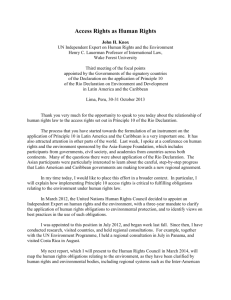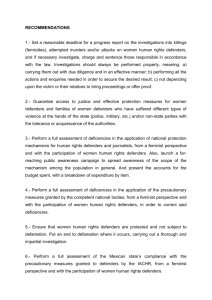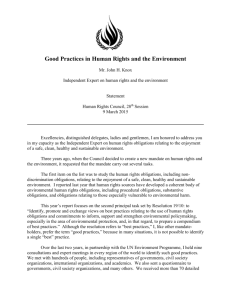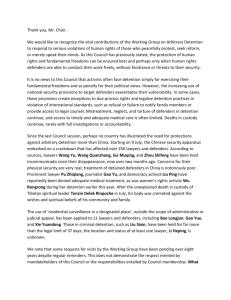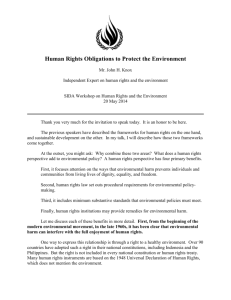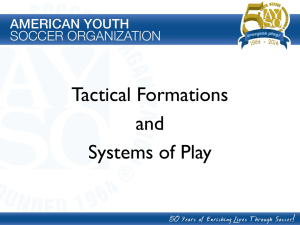The Front Line of Environmental Protection
advertisement
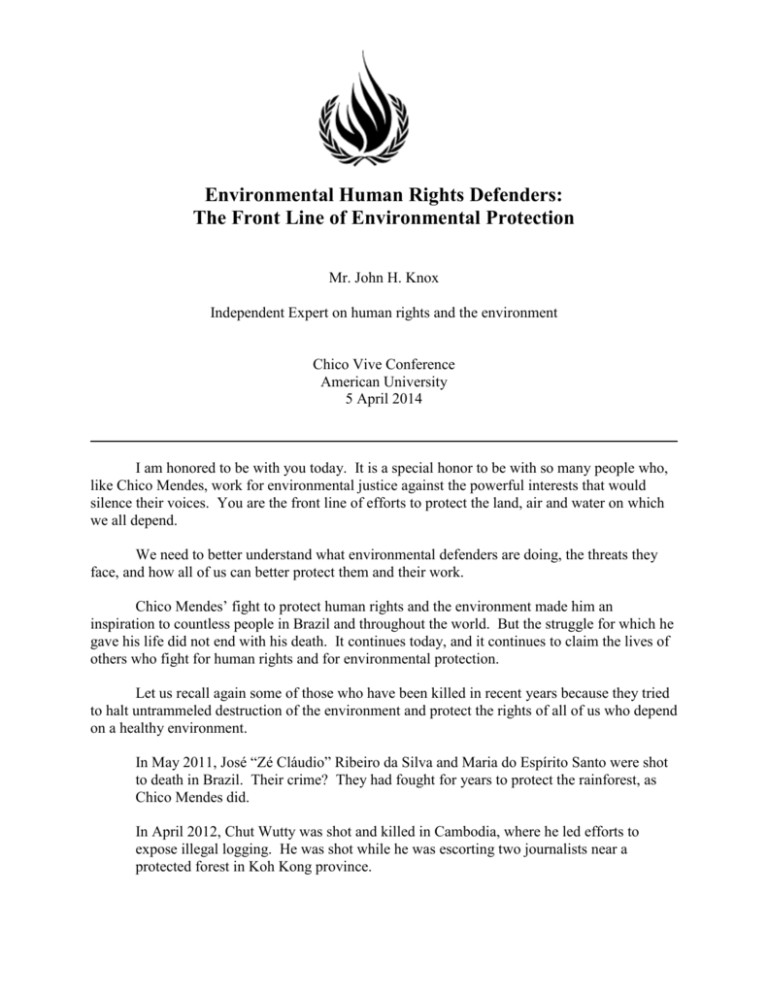
Environmental Human Rights Defenders: The Front Line of Environmental Protection Mr. John H. Knox Independent Expert on human rights and the environment Chico Vive Conference American University 5 April 2014 I am honored to be with you today. It is a special honor to be with so many people who, like Chico Mendes, work for environmental justice against the powerful interests that would silence their voices. You are the front line of efforts to protect the land, air and water on which we all depend. We need to better understand what environmental defenders are doing, the threats they face, and how all of us can better protect them and their work. Chico Mendes’ fight to protect human rights and the environment made him an inspiration to countless people in Brazil and throughout the world. But the struggle for which he gave his life did not end with his death. It continues today, and it continues to claim the lives of others who fight for human rights and for environmental protection. Let us recall again some of those who have been killed in recent years because they tried to halt untrammeled destruction of the environment and protect the rights of all of us who depend on a healthy environment. In May 2011, José “Zé Cláudio” Ribeiro da Silva and Maria do Espírito Santo were shot to death in Brazil. Their crime? They had fought for years to protect the rainforest, as Chico Mendes did. In April 2012, Chut Wutty was shot and killed in Cambodia, where he led efforts to expose illegal logging. He was shot while he was escorting two journalists near a protected forest in Koh Kong province. In May 2012, Margarito Cabal was killed in the Philippines. He was opposing a hydroelectric mega dam that would submerge 22 villages. He was the thirteenth environmentalist killed in the Philippines in the previous two years. In May 2013, Jairo Mora Sandoval, a 26-year-old conservationist trying to protect sea turtles, was killed on the Atlantic coast of Costa Rica, apparently by poachers. In September 2013, Adelinda Gomez Gaviria was killed in Colombia. She opposed gold mining because of its harm to the environment and to the livelihoods of peasant farmers. A month before her death, she received a telephoned death threat: “stop messing around with this mining thing, it’s risky and you’re going to get yourself killed.” Murder is the gravest threat faced by environmental human rights defenders, but it is not the only one. They are also subject to harassment, violence, and detention. To give just one recent example, Yevgeny Vitishko became famous in February because of the Winter Olympics in Sochi, Russia. He isn’t an athlete or a coach; he is an environmentalist who co-wrote a report on the environmental harm caused by the Sochi Olympics. Government officials arrested him and sentenced him to 15 days in prison for the crime of swearing in public. He was later sentenced to three years in prison for violating parole on a sentence of spray painting graffiti on a fence built arguably illegally in a protected area. In many ways, environmental defenders are like others who try to defend human rights: they stand up for others’ rights at great personal risk. In that sense, they are in the company of Mohandas Gandhi, Nelson Mandela, and Aung San Suu Kyi. In fact, environmental defenders are often at greater risk than other human rights defenders. The United Nations Special Rapporteur on human rights defenders receives hundreds of communications each year concerning violations of the rights of human rights defenders. Based on the communications, in 2007 the Special Rapporteur reported that “the second most vulnerable group when it comes to the danger of being killed because of their activities in the defence of human rights, are defenders working on land rights and natural resources.” [A/HRC/4/37, ¶ 45]. Last August, she reported that their situation appears to have worsened since 2007 [A/68/262, ¶ 18]. She described the extraordinary risks, including threats, harassment, and physical violence, faced by those defending the rights of local communities when they oppose projects that have a direct impact on natural resources, the land or the environment [A/68/262, ¶ 15). In 2012, Global Witness published a study that reached the same conclusion. It counted the number of people killed over the previous decade, from 2002 to 2011, who were defending their human rights, or the rights of others, related to the environment, specifically land and forests. It found that 711 individuals were reported killed – more than one a week. The death toll had greatly increased over that time – 106 were killed in 2011, nearly twice the toll in 2009. Global Witness stated that “[t]his rise may be partly due to better technologies allowing for better information sharing and collation. However, a rise in killings would corroborate our own sense, and that of others, that violent disputes over land and forests between communities, 2 activists, land owners, companies and authorities are occurring more frequently.” [p. 5] The countries with the highest number of reported deaths were Brazil, Peru, Colombia, and the Philippines. But Global Witness emphasized that as high as it is, this number almost certainly understates the true number of killings. Killings in some countries, such as Brazil, are more likely to be reported than in others. And Global Witness did not examine people killed in conflicts over gas and oil, instead focusing on disputes over land and forests. Global Witness has conducted another, more detailed study that is due out later this month. It will show that the problem is even worse than previously realized, and that action is needed even more urgently. Why are environmental defenders at such great risk? Many of you here can answer that question better than I can, I expect, based on your own experience. But in other meetings and reports, defenders have identified some common patterns. First, and perhaps most important, they are taking on powerful, wealthy interests. Again in the words of Global Witness, “Most commonly, those killed were protesting or making grievances against mining operations, agribusiness, logging operations, tree plantations, hydropower dams, urban development and poaching.” Similarly, the Special Rapporteur on human rights defenders has emphasized that these defenders are often taking on large-scale development projects. Some of the projects are governmental, but many are run by private corporations, which can lead to direct human rights abuses by those corporations. The Special Rapporteur has pointed to “instances in which security guards employed by oil and mining companies had allegedly threatened to kill, harassed and attacked human rights defenders protesting against the perceived negative impact of corporate activities on the enjoyment of human rights by local communities. She also highlighted cases in which local authorities had allegedly colluded with the private sector and cases in which private companies had aided and abetted the commission of violations against human rights defenders [A/65/223 (2010), ¶¶10, 11, A/68/262 (2013), ¶ 18]. These projects involve enormous amounts of money, which creates enormous incentives for all those who benefit to remove all opposition. The money can also corrupt government officials. These large projects are often seen by the country as important to its economic development. Therefore, those opposing them are stigmatized, often by the government as well as corporations or landowners. Second, defenders are often ordinary people thrust into extraordinary situations. They begin by simply trying to defend their own rights or those of their community and find themselves up against enormously powerful interests. As one person put it to me, they are “accidental” human rights defenders. They often don’t know that they’re human rights defenders. Perhaps the label doesn’t matter so much, but 3 the more important point is that they don’t have access to institutional protections, or even contacts with international or national organizations that might help to protect them. Let me give you the example of Phyllis Omido, from Mombasa, Kenya. She worked at a battery smelter. When her young son became ill, she was told in confidence by another worker there that she should have him checked for lead poisoning. She had no idea what lead poisoning was. But she found out that lead was a pollutant that can cause brain and neurological harm, especially in children. She also found out that the smelter was producing lead pollution, and it was trying to hide how much pollution it was causing. She eventually left her community, but found that she had become a kind of focal point for other concerned workers and residents around the smelter. She was threatened with death, arrested, beaten up – but she didn’t give up. A third common factor in many cases is that these environmental defenders are often overlooked by major human rights organizations and major environmental groups. Often it seems that the international human rights organizations don’t get involved until after something happens that makes the case look more like a traditional human rights problem. For example, at the meeting in Geneva, one participant said that Yevgeny Vishtinko didn’t receive much outside attention until after he was arrested. And international environmental organizations may not feel that it’s up to them to tackle human rights issues. I think this last factor may be changing. Increasingly, the large international organizations, both human rights and international environmental organizations, see these threats to environmental human rights defenders as a critical issue. As a result, they are working to bring attention to the problem, and to work more closely with local defenders. Human Rights Watch, for example, has worked closely with Phyllis Omido; other organizations, like Greenpeace, AIDA, WRI, and many others, are increasingly successful at bringing attention to these issues. More generally, the link between environment and HR is now much better recognized. In March 2012, the Human Rights Council decided to appoint an Independent Expert to a threeyear mandate to clarify the human rights obligations relating to enjoyment of a healthy environment, and to identify good practices in that respect. I have the honor of being appointed to that position. Last month, I reported to the Council on the results of a project that I had overseen to map the human rights obligations. With the help of scholars and attorneys working on a pro bono basis, we conducted the most thorough review ever undertaken of this question. We examined the text of human rights treaties, statements by human rights treaty bodies, decisions of regional human rights tribunals, resolutions of the General Assembly and the Human Rights Council, statements by States in the context of the Universal Periodic Review, reports by Special Rapporteurs, and international environmental instruments. I also held five consultations, with participants from every region. The results are contained in fourteen reports, each of which describes the application of human rights obligations to environmental issues by one source or set of sources. Despite the diversity of the sources reviewed, they have taken remarkably consistent positions. 4 Virtually every source has identified rights whose enjoyment is infringed by environmental degradation. Environmental harm obviously threatens the right to a healthy environment, which is now recognized by most countries in the world. It also interferes with the exercise of many rights recognized by all countries, including rights to life, health, food, water, and even self-determination. But human rights bodies have gone beyond describing the effects of environmental harm on the enjoyment of human rights. Together, they have developed a coherent body of environmental human rights obligations, with three principal elements. First, they agree that human rights law imposes procedural obligations on States in relation to environmental protection. These obligations are: (a) to assess environmental impacts and make environmental information public; (b) to facilitate public participation in environmental decision-making, including by protecting the rights of expression and association; and (c) to provide access to effective remedies for environmental harm. o These obligations are often considered to correspond to civil and political rights, but in the environmental context they have been derived from the full range of human rights whose enjoyment is threatened by environmental harm, including rights to health, food, and water. Second, States have substantive obligations to protect against environmental harm that interferes with the enjoyment of human rights. Specifically, States have an obligation to adopt a legal framework that protects against such environmental harm. This obligation includes a duty to protect against such harm when it is caused by corporations and other non-State actors, as well as by State agencies. The obligation to protect human rights from environmental harm does not require the cessation of all activities that may cause any environmental degradation. States have discretion to strike a balance between environmental protection and other issues of societal importance, such as economic development and the rights of others. But the balance cannot be unreasonable, or result in unjustified, foreseeable infringements of human rights. In determining whether an environmental law has struck a reasonable balance, relevant factors include whether it meets national and international health standards, and whether it is retrogressive. There is a strong presumption that retrogressive measures are not permissible. Moreover, once a State has adopted environmental standards into its law, it must implement and comply with those standards. Third, States must take into account the situation of groups particularly vulnerable to environmental harm. States must not discriminate against groups on prohibited grounds in the application of their environmental laws and policies. And they must take additional steps to 5 protect certain groups. For example, States should ensure that women are able to participate in environmental decision-making, and States should take care to address environmental harm that may have disproportionate effects on women. Similarly, States should, in the words of the Committee on the Rights of the Child, “take measures to address the dangers and risks that . . . environmental pollution poses to children’s health.” Because of their close relationship with the environment, indigenous peoples are particularly vulnerable to impairment of their rights through environmental harm. As the Special Rapporteur on the rights of indigenous peoples has stated, “the implementation of natural resource extraction and other development projects on or near indigenous territories has become one of the foremost concerns of indigenous peoples worldwide, and possibly also the most pervasive source of the challenges to the full exercise of their rights” (A/HRC/18/35, para. 57). The law on indigenous peoples and environmental harm is now well developed. It requires, among other duties, that States recognize the rights of indigenous peoples with respect to the territory that they have traditionally occupied, and facilitate the participation of indigenous peoples in decisions that concern them. In general, “extractive activities should not take place within the territories of indigenous peoples without their free, prior and informed consent.” And States must ensure that indigenous communities affected by environmental development receive a reasonable benefit from any such development. In sum, on the basis of this mapping project, I believe that it is now beyond argument that human rights law includes obligations relating to the environment. Those obligations apply with particular force to environmental human rights defenders. There is no doubt that there’s a right to participate in the government of your country, a right to freedom of speech, and a right to freedom of association. Those rights are recognized and protected by the 1948 Universal Declaration, the 1966 ICCPR, and many regional agreements, including the American Convention. It’s absolutely clear that those rights extend to people seeking to exercise them in the context of environmental protection. The importance of public participation is also reflected in many international environmental instruments. Principle 10 of the Rio Declaration states: “Environmental issues are best handled with participation of all concerned citizens, at the relevant level… Each individual shall have… the opportunity to participate in decision-making processes.” In 2012, in The Future We Want, the outcome document of the United Nations Conference on Sustainable Development (Rio+20 Conference), States recognized that “opportunities for people to influence their lives and future, participate in decision-making and voice their concerns are fundamental for sustainable development” (A/CONF.216/16, para. 13). States have obligations not only to refrain from violating the rights of free expression and association directly, but also to protect the life, liberty and security of individuals exercising those rights. Again, there can be no doubt that these obligations apply to those exercising their rights in connection with environmental concerns. 6 The Special Rapporteur on the situation of human rights defenders has emphasized that States should recognize the important work carried out by human rights defenders working on land and environmental issues in trying to find a balance between economic development and environmental protection, should not tolerate their stigmatization and should ensure prompt and impartial investigations into alleged violations of their rights. Similarly, the Inter-American Court stated, in a case called Kawas-Fernandez v Honduras, that “States have the duty to provide the necessary means for human rights defenders to conduct their activities freely; to protect them when they are subject to threats in order to ward off any attempt on their life or safety; to refrain from placing restrictions that would hinder the performance of their work, and to conduct serious and effective investigations of any violations against them, thus preventing impunity.” ¶ 145 The Court made clear that these obligations apply to those working on behalf of the environment. The case concerned the 1995 murder of Blanca Jeannette Kawas-Fernandez, the president of an organization called PROLANSATE, which worked to protect the environment and the rights of people in the Bahia de Tela watershed. The Court found that at least one agent of the State was involved in the murder, that the State had done little or nothing to bring the perpetrators to justice, and that “it is undeniable that these circumstances have also had an intimidating effect on other people who are engaged in the defense of the environment in Honduras.” [¶¶ 152, 153] The Court ordered an extraordinary range of remedies, including not only that Honduras pay reparations and revitalize the criminal investigation, but also that it publicly acknowledge responsibility, construct a monument to the memory of Kawas-Fernandez, and “carry out a national awareness and sensitivity campaign regarding the importance of the work performed by environmentalists in Honduras and their contribution to the defense of human rights.” So, again, the international law is clear. The problem, as it so often is, in international human rights law, is implementation. States often fail to live up to their obligations, and even resist acknowledging them. Last Friday, at the close of the March session of the Human Rights Council, the Council adopted a resolution by consensus, with over 70 co-sponsors, that recognized “that human rights law sets out certain obligations on States which are relevant to the enjoyment of a safe, clean, healthy and sustainable environment, and that the enjoyment of the corresponding human rights and fundamental freedoms can be facilitated by assessing environmental impacts, by making environmental information public, and by enabling effective participation in environmental decision-making processes, and in that regard a good practice includes adopting, strengthening and implementing laws and other measures to promote and protect human rights and fundamental freedoms in the context of environmental legislation and policies.” 7 As originally drafted, the resolution also stated: the Council “recognizes the important role played by human rights defenders working on environmental issues in trying to promote sustainable development . . . and urges States to create a safe and enabling environment in which these human rights defenders can operate free from hindrance and insecurity” That language was too controversial. It was replaced by: The Council “recognizes the important role played by . . . human rights defenders in the promotion and protection of human rights as they relate to the enjoyment of a safe, clean, healthy and sustainable environment.” We must do better. Efforts to raise the profile of the issue are crucially important. It’s also important to find better ways of protecting EHRDs at risk. I’m trying, with the help of many others, to identify good practices in this area. To that end, I attended a meeting last month in Geneva, mainly with African and European EHRDs; next month I’ll be in Bangkok with Asian defenders; and of course today I’m here! I would be highly interested in your views on what practices you think I should identify and promote. Let me give some examples raised in other forums. o Phyllis Omido got in touch with Human Rights Watch, a major international human rights organization – which helped bring attention to her situation and thereby protect her, at least to some degree. o Dima Litvinov, one of the Greenpeace activists who were arrested by Russia for protesting against Arctic oil drilling and threatened with prison for piracy said at the Geneva meeting that outside pressure got them out. o Another activist described how she had created networks of EHRDs from different parts of the country to meet one another and share experiences. o Others proposed education campaigns to help to inform EHRDs of their rights, their avenues to international human rights mechanisms such as the InterAmerican Commission and Court, how to document and obtain evidence, etc. These may seem like small steps, but they can be important. Obviously many things are going on here today, so don’t feel that you have to provide me information here! But I hope that you do contact me with your ideas and suggestions. I want to close by returning to Jeannette Kawas Fernandez, the Honduran activist killed for trying to protect a protected area. Here’s a picture of the beautiful park named after her. 8 The environment, and the people who depend upon it, are worth fighting for. We must do a better job of protecting those who are on the front line of the fight. Thank you very much. 9

